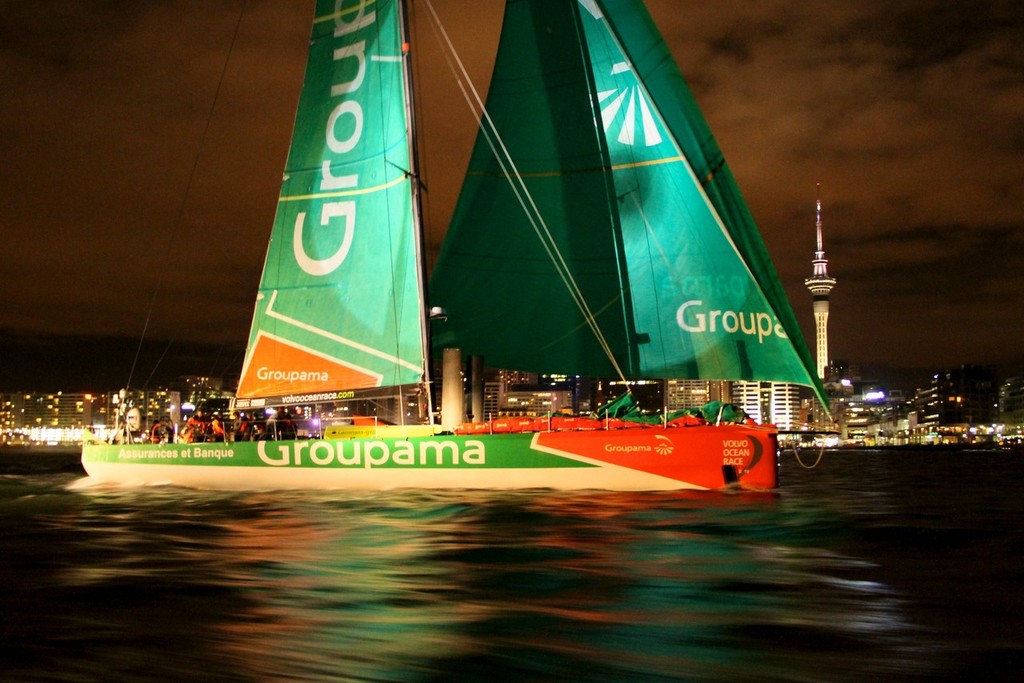Volvo Inmarsat Report- Leg 4 'Too long and hard was the consensus'
by Mark Covell on 13 Mar 2012

Groupama finishes almost 12 hours ahead of the second placed Puma, with the rest of the fleet finishing inside two hours Richard Gladwell
www.photosport.co.nz
Courtesy of www.volvo.inmarsat.com!Inmarsat, Olympic medallist and Volvo veteran Mark Covell, draws on his career as a professional yachtsman to bring you unrivalled analysis of the Volvo Ocean Race, as it unfolds.
As Official Satellite Communications partner, www.volvo.inmarsat.com!Inmarsat plays a pivotal role in making the Volvo Ocean Race 2011-12 happen. Their satellites provide the voice and broadband links for the yachts that enable the media crew members (MCMs) to beam HD video, photographs and news back to the waiting world, as well as keeping the yachts connected to Volvo Ocean Race HQ.
Groupama romped home on Saturday night with a healthy lead over the chasing pack. The French are the first to beat the Spanish to the top slot.
It’s a difficult call to start rating the legs as each one brings its own challenges. But seeing the drawn faces of the crews as they pulled into the dock told a story of its own. And when I asked them directly how the leg was, I got a similar tale from all. Too long and hard was the consensus.
This was by no means a straightforward leg, one where they could just leave dock and head directly for the next port of call, Auckland.
Raging gale
A raging gale in the South China Sea threw up a dangerously confused wave state in its shallow waters, so Volvo race management took the unprecedented decision to let the fleet start on time with a short coastal race, but then suspend sailing and have the teams dock back into Sanya until the storm abated.
Due to tricky offshore conditions Puma fell into a light wind zone behind a headland and ended up 45 minute behind the fleet. That meant restarting the leg that much behind the pack. How frustrating was that?!
Steep seas
Once on the way, teams complained of a horrendous wave state, made worse by having to sail upwind into the steep seas.
It was like constantly driving too fast over speed bumps in a sports car for days on end.
The crews were battered from the outset. Many suffered from seasickness for the first time in their lives, such was the testing conditions.
Trade winds
Simply turning south towards Auckland was not option. The trade winds they were looking to carry them to New Zealand were blowing a lot further east than expected.
This resulted in a week-long drag race east. They knew that the faster and further they sailed east, the more wind and better angle they’d have on the sleigh-ride south - like swimming away from the riverbank to get into the faster flowing water in the middle. The teams realised early on that they’d have to ration their food for a longer leg then expected.
The only joker in the pack was Puma. Due to their late start out of Sanya they trailed the fleet through the South China Sea and the Strait of Luzon. When you’re behind and see little gain from just following the pack you start to look for alternative routes.
Opposite direction
And when I say alternative routes I don’t generally mean the opposite direction - but Puma literally turned north. This radical move meant sailing hundreds of miles further then the other teams.
The great thing about this fairy tale story is that you only need a little more wind to go a lot faster. This was the formula that rocketed Puma from dead last to second just behind Groupama. A position they held until the finish.
The exceptional demands of this leg required the fleet to weigh some difficult decisions. The Solomon Islands forced half the fleet to cut the corner and sail headlong through the archipelago in the pitch black, dodging reefs and wrecks.
Tightly bunched
You’d have thought that by the end, after 6,000 nm and so many obstacles the boats would’ve been scattered across hundreds of miles. But apart from Groupama, they were tightly bunched.
Puma clinched second, which was a nice prize after her poor start. And Telefonica and local team Camper had a fight to the finish with only 93 seconds between them. It was amazing to see them all sail in so close together. It only shows how evenly matched they are.
The ability to sail fast and hook into better winds was the key to this last leg, which according to Ian Walker, skipper of Abu Dhabi Ocean Racing, called for immense focus and dogged perseverance.
For the rest of this story http://covellonvolvo.blogspot.co.nz/2012/03/rough-ride-south-puts-battered-sea-legs.html!click_here
For Mark Covell's blog on the Volvo Ocean Race, courtesy of www.volvo.inmarsat.com!Inmarsat http://volvo.inmarsat.com/race-coverage/blog.html!click_here
If you want to link to this article then please use this URL: www.sail-world.com/94841